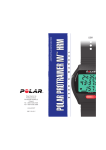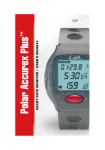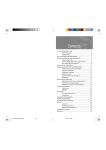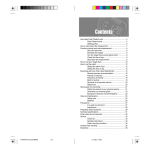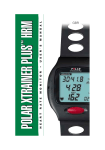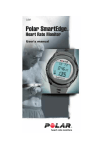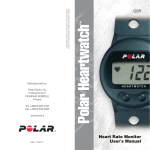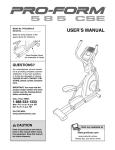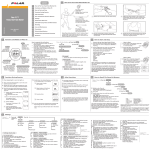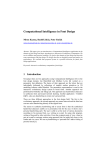Download User's Manual GBR
Transcript
User's Manual P O L A R VA N TA G E N V ™ GBR TM HEART RATE MONITOR TABLE OF CONTENTS Quick reference guide Introduction ..................................................................................... 4 Precautions ................................................................................. 5 Before you begin ........................................................................ 5 How does the Polar Vantage NV work ? ......................................... 6 Polar Vantage NV Parts .............................................................. 6 Wearing the Polar Vantage NV ................................................... 7 How to set the watch ...................................................................... 8 Setting the 12h/24h mode .......................................................... 8 Setting the alarm ........................................................................ 9 Setting the time ......................................................................... 10 Setting the date ........................................................................ 10 How to set the HRM functions ...................................................... 12 Setting the Timers 1 and 2 ....................................................... 13 Setting Heart Rate Limits 1 and 2 ............................................. 14 Setting the Training Thresholds ............................................... 15 Setting the Recovery Heart Rate / Recovery Time ................... 16 Setting the Heart Rate Reception Distance .............................. 17 Setting the Time Display ........................................................... 18 Setting the Relaxation / Lap Display ........................................ 18 Setting the Memory Deletion .................................................... 19 How to start the Heart Rate measurement .................................... 20 How your Polar Vantage NV automatically sets the transmission code ........................................................... 20 What can you do with the Polar Vantage NV during the Heart Rate measurement? ........................................... 22 How to view the recorded information .......................................... 25 Changing the recording interval ............................................... 25 Recalling the training information ............................................. 26 Deleting the most recent file ..................................................... 27 How to get more out of your Polar Vantage NV ............................ 28 Care and maintenance ................................................................. 29 Help ! ............................................................................................ 30 Troubleshooting ........................................................................ 30 Helpful hints .............................................................................. 31 Polar Glossary .......................................................................... 32 Compatibility with other Polar products ................................... 38 Technical specification ............................................................. 38 Polar Books and Accessories ....................................................... 39 Service .......................................................................................... 40 Limited Polar Warranty .................................................................. 41 Disclaimer ..................................................................................... 42 2 3 INTRODUCTION Congratulations on purchasing the Polar Vantage NV Heart Rate Monitor ! You are now the owner of the most advanced and sophisticated HRM in the world offering features and performance exceeding any other HRM available, including: WATCH FUNCTIONS • watch with alarm clock, calendar and weekday indicator • 12/24 h display • stopwatch with split / lap time counter • alternate displays in measurement mode (total exercising time or time of day) HEART RATE MONITORING FUNCTIONS • wireless heart rate monitoring with ECG accurate continuous measurement • coded transmission of heart rate • two freely programmable target zones • visual and audible alarm for each target zone limit • time spent above, within and below each target zone • with each lap/split time corresponding heart rate information • two programmable, alternating timers • average heart rate for each lap • maximum, average and minimum heart rate of the total exercise period • Recovery Heart Rate / Recovery Time after each lap • freely programmable Training thresholds • time below Lower Training threshold, between Lower and Upper Training thresholds and above Upper Training threshold • graphic and numeric display of Relaxation Rate • two ranges of heart rate reception distance RECORDING FUNCTIONS • ability to record up to 134 hours of performance information with unlimited number of files • complete file identification system (date, time of day, number of file) • automatic recording ability with RR (beat to beat) -intervals and every 5, 15, 60 seconds • ability to use the Polar Vantage NV Receiver as a stopwatch with manual heart rate recording • ability to let the oldest file be replaced by a new one during recording • an indicator for the amount of free memory shows up on display each time when starting a new recording 4 OTHER FUNCTIONS • electroluminescent backlight • ability to activate the backlight and to check time of day / split time, Heart Rate Limits in use and the transmission code while exercising • ability to recall the memory file by file on receiver display DATA TRANSFER AND OTHER FUNCTIONS WITH OPTIONAL INTERFACE • ability to download performance data into a computer for detailed analysis • ability to upload settings for watch and HRM functions from PC • ability to show user´s ID on the display of the receiver This user’s manual is designed to show precisely what the Polar Vantage NV Heart Rate Monitor can do and how you can use each feature to best accomplish your personal fitness and performance goals. Precautions • Do not stretch or bend the Transmitter especially when storing it. • Do not operate the buttons of your Polar Vantage NV HRM under water. • Wash and dry your Polar Transmitter regularly after use; never store it wet. • Do not store your Polar Vantage NV HRM in any kind of nonbreathable material, such as a plastic bag or sports bag. Store it in a dry place. • Keep your Polar Vantage NV HRM out of extreme cold or heat. Before you begin Before starting any exercise program, always consult your physician. If you have a pacemaker or other implanted electronic device, consult your physician and/or the manufacturer of the device prior to using the Polar Vantage NV Heart Rate Monitor. 5 HOW DOES POLAR VANTAGE NV WORK Wearing the Polar Vantage NV HRM Polar Vantage NV parts 2. Adjust the strap length to fit snugly and comfortably. The Polar Vantage NV HRM consists of three parts: 3. Wet the grooved electrode areas on the backside of the Polar Coded Transmitter. 1. Attach the Polar Coded Transmitter to the elastic strap. 1. The Polar Coded Transmitter The key to flawless operation is to wet the grooved electrode areas carefully. 4. Secure the strap around your chest, below the breasts. Lock the buckle. 5. Check that the grooved and wet electrode areas are against your skin and the Polar logo is in a central upright position. E D C O Grooved electrode areas D 2. The Elastic Strap It is recommended that you wear the Transmitter against your bare skin to ensure flawless operation. However, if you wish to wear the Transmitter over a shirt, moisten the shirt well under the electrodes. 6. Put on the Receiver as you would put on an ordinary watch. It is important that the electrodes are wet during the exercise. However, after exercising, wash and dry the Transmitter carefully to save the electrodes and battery life. 3. The Wrist Receiver 6 7 HOW TO SET THE WATCH In the Time of Day display you can set the following three watch functions: - Alarm - Time - Date Each function is represented by a block in the graphic bar in the above order. A flashing block means that you are setting the corresponding function. Setting the 12/24h display 1. In the Time of Day display, press and hold SET/ START/STOP. Release. 12 h mode with AM/PM indicator is activated. 2. Press and hold again. Release. 24 h mode is activated. 3. The chosen mode is now used in all watch and alarm functions. If you chose the 24 h mode you can skip those parts in the following instructions, which advise you to set AM or PM. Start here for the setting of alarm, time and/or date: 1. In the Time of Day display press the SET/START/STOPbutton. • SET starts to flash in the upper right corner of the display. • ALM appears on the display. • Alarm symbol starts to flash. • The uppermost block of the graphic bar on the right, representing the setting of Alarm, starts to flash. 2. Go through the setting of alarm, time and date step by step by following the instructions. 8 You can also go directly to set just one particular function by pressing SET/START/STOP shortly as many times as needed until you see the corresponding symbol of the desired function in the display and the block flashing. Now follow the instructions for setting that particular function. Setting the alarm Alarm Symbol is flashing. 1. Press SIGNAL/LIGHT to set the alarm on appears) or alarm off ( disappears). ( 2. Press STORE/LAP/RECOVERY to lock your selection. AM starts flashing. 3. Press SIGNAL/LIGHT to select AM or PM. 4. Press STORE/LAP/RECOVERY to lock your selection. The first two digits, representing the hours, start flashing. 5. Press SIGNAL/LIGHT to select the desired hour. The digits run faster if you press and hold the SIGNAL/LIGHT button. Release the button when the desired value is approaching. 6. Press STORE/LAP/RECOVERY to lock your selection. The last two digits, representing the minutes, start flashing. 7. Press SIGNAL/LIGHT to select the desired minutes. 8. Press STORE/LAP/RECOVERY to lock your selection. 9. Press SET/START/STOP to enter the time setting mode. AM starts flashing. 10. Now continue from Setting the time. To return immediately to Time of Day display, press the SELECT button twice. When the alarm comes on it will sound for one minute or you can turn it off by pressing STORE/LAP/RECOVERY button. 9 Setting the time 3. Press SIGNAL/LIGHT to select the month. AM/PM (alternatively the first two digits) are flashing. 4. Press STORE/LAP/RECOVERY to lock your selection. The last two digits, representing the day, start flashing. 1. Press SIGNAL/LIGHT to select AM or PM. 5. Press SIGNAL/LIGHT to select the desired day. 2. Press STORE/LAP/RECOVERY to lock your selection. The first two digits, representing the hours, start flashing. 3. Press SIGNAL/LIGHT to select the desired hour. 4. Press STORE/LAP/RECOVERY to lock your selection. The next two digits, representing the minutes, start flashing. The last two digits representing the seconds go to zero. 6. Press STORE/LAP/RECOVERY to lock your selection. The digits in the lower right corner, representing the weekdays, start flashing. 7. Press SIGNAL/LIGHT to select the desired weekday. 8. Press STORE/LAP/RECOVERY to lock your selection. The two digits, representing the year, start flashing. 9. Press SET/START/STOP to enter the alarm setting mode. Press the SELECT button to return to the time of day display. 5. Press SIGNAL/LIGHT to select the desired minutes. 6. Press STORE/LAP/RECOVERY to lock your selection. 7. Press SET/START/STOP to enter the date setting mode. The seconds start running. The two first digits of date, representing the year, start flashing. 8. Now continue from Setting the date. To return to time of day display immediately, press the SELECT button twice. Setting the date The first two digits are flashing. 1. Press SIGNAL/LIGHT to select the year. 2. Press STORE/LAP/RECOVERY to lock your selection. The second digits, representing the month, start flashing. 10 11 HOW TO SET THE HRM FUNCTIONS In the SET-mode you can set the following ten different HRM functions in your Polar Vantage NV HRM: - Timer 1 - Timer 2 - Heart Rate Limits 1 - Heart Rate Limits 2 - Training thresholds - Recovery Heart Rate / Recovery Time - Heart Rate Reception Distance - Time Display - Relaxation / Lap Display - Memory deletion Each of these functions is represented by a block in the graphic bar in the above order. A flashing block means that you are setting the corresponding function. Start here to set any of these functions: 1. In the Time of Day display press the SELECT-button three times. SET starts to flash in the upper right corner of the display. The uppermost block of the graphic bar on the right, representing the setting of Timer 1, starts to flash. 2. Go through the settings step by step for each of these functions by following the instructions. You can also go directly to set any particular function. If you prefer this, press SET /START/STOP shortly as many times as needed until you see the corresponding symbol of the desired function in the display and the block flashing. Now follow the instructions for setting that particular function. Setting the Timers 1 and 2 The first two digits, representing the minutes of Timer 1, flash. If you don’t want to use the timer, set the value to zero. 1. Press SIGNAL/LIGHT to select the desired minutes. The digits will run faster if you press and hold the SIGNAL/LIGHT button. Release the button when the desired value is approaching. 2. Press STORE/LAP/RECOVERY to lock your selection. The last two digits, representing the seconds of the Timer, start to flash. 3. Press SIGNAL/LIGHT to select the desired seconds. 4. Press STORE/LAP/RECOVERY to lock your selection. 5. Press SET/START/STOP to enter the setting mode of Timer 2. The second block of the graphic bar on the right, representing the setting of Timer 2, starts to flash. The first two digits, representing the minutes of the Timer 2, start to flash. 6. Repeat the steps from 1 to 4 to set the Timer 2. You can set the Timer 2 only if the Timer 1 has been set. If you want to set only the Timer 1, set the value for Timer 2 in zero. Timers start running when you start the stopwatch. Timer 2 will follow Timer 1 and they will alternate accordingly when the stopwatch is running. 7. Press SET/START/STOP to set the Heart Rate Limits. The third block of the graphic bar on the right, representing the setting of the Heart Rate Limits 1, starts to flash. The upper reading, representing the Upper Limit 1, starts to flash. 12 13 Setting the Heart Rate Limits 1&2 Setting the Training thresholds The upper reading is flashing. The upper reading is flashing. 1. Press SIGNAL/LIGHT to select the desired value for the Upper Limit 1. 1. Press SIGNAL/LIGHT to select the desired value for the Upper training threshold. The digits will run faster if you press and hold the SIGNAL button. Release the button when the desired value is approaching. Training thresholds can be used to analyse your training with respect to predefined thresholds such as aerobic threshold and anaerobic threshold (Lactate threshold, OBLA). Training thresholds are very individual and can be determined most accurately in the laboratory tests. The programming range for Upper/Lower Threshold is 10-240. You can not set the upper limit lower than the lower limit. The range for the heart rate limits is 10 - 240. 2. Press STORE/LAP/RECOVERY to lock your selection. The lower reading, representing the Lower Limit 1, starts to flash. 3. Press SIGNAL/LIGHT to select the desired Lower Limit 1. 4. Press STORE/LAP/RECOVERY to lock your selection. 5. Press SET/START/STOP to enter the setting mode of Heart Rate Limits 2. The fourth block of the graphic bar on the right, representing the setting of the Heart Rate Limits 2, starts to flash. The upper reading, representing the Upper Limit 2, starts to flash. 6. Repeat the steps 1 to 4 to set the Heart Rate Limits 2. 2. Press STORE/LAP/RECOVERY to lock your selection. The lower reading, representing the Lower training threshold, starts to flash. 3. Press SIGNAL/LIGHT to select the desired value for the Lower training threshold. 4. Press STORE/LAP/RECOVERY to lock your selection. 5. Press SET/START/STOP to set the Recovery Heart Rate or alternatively Recovery Time. The sixth block of the graphic bar on the right, representing the setting of the Recovery Heart Rate/Recovery Time, starts to flash.The upper right digits (HR), representing the Recovery Heart Rate mode, start to flash. 7. Press SET/START/STOP to enter the setting mode of Training thresholds. The fifth block of the graphic bar on the right, representing the setting of the Upper/lower training thresholds, starts to flash. The upper reading, representing the Upper Training threshold, starts to flash. 14 15 Setting the Recovery Heart Rate / Recovery Time HR (alternatively TI) is flashing. CHOOSE FROM THESE RECOVERY FUNCTIONS: Recovery Heart Rate (RECO HR) Measures how much the heart rate decreases during the pre-set period of time. You define the period of time in minutes and seconds. Recovery Time (RECO TI) Measures the time until a certain heart rate reading is reached. You define the heart rate reading you want to reach. 5. Press SET/START/STOP to enter the setting of the Heart Rate Reception Distance. DIST appears on the display. The seventh block of the graphic bar on the right, representing the setting of the Heart Rate Reception Distance starts to flash. The reading starts to flash. Setting the Heart Rate Reception Distance The reading is flashing. 1. Press SIGNAL/LIGHT to select the Heart Rate Reception Distance. Choose 100 % as the normal Heart Rate Reception Distance. Also, if you have extra long arms, if you are rowing or attaching the Wrist Receiver to something other than your wrist, choose 100 %. 1. Press SIGNAL/LIGHT to choose RECO HR or RECO TI. 2. Press STORE/LAP/RECOVERY to lock your selection. If you selected RECO HR, 00:00 appears on the display and starts to flash. If you selected RECO TI, 00 appears on the display and starts to flash. 3. Press SIGNAL/LIGHT to select the desired value. If you selected earlier RECO HR, first select the desired value for the minutes. Press STORE/LAP/RECOVERY to lock your selection. Then press SIGNAL/LIGHT to select the desired value for the seconds. Choose 70 % if you think there are going to be possible interferences, for example exercise equipment near you. If you choose the 70 % distance, you should make sure that you keep the Receiver within approximately 70 centimeters from the Transmitter. 2. Press SET/START/STOP to enter the setting of the Time Display. DISP 1 appears on the display. The eighth block of the graphic bar on the right, representing the setting of the Time Display, starts to flash. If you selected earlier RECO TI, select now the desired heart rate value. The digits run faster if you press and hold the SIGNAL/LIGHT button. Release the button when the desired value is approaching. 4. Press STORE/LAP/RECOVERY to lock your selection. HR/TI starts to flash. 16 17 Setting the Time Display 00:00.0 (alternatively time of day) is flashing. 1. Press SIGNAL/LIGHT to select the desired Time Display. 2. Press SET/START/STOP to enter the setting of the Memory Deletion DEL FILES appears on the display. The last block of the graphic bar on the right, representing the setting of the Memory Deletion, starts to flash. NO (alternatively YE) strats to flash. CHOOSE FROM THESE ALTERNATIVES: Setting the Memory Deletion 00:00.0 Displays stopwatch time during heart rate measurement. NO (alternatively YE) is flashing. Time of Day Displays time of day during heart rate measurement. 1. Press SIGNAL/LIGHT to select the desired option. CHOOSE FROM THESE ALTERNATIVES: 2. Press SET/START/STOP to enter the setting of the Relaxation/Lap Display. DISP 2 appears on the display. The ninth block of the graphic bar on the right, representing the setting of the Relaxation/Lap Display, starts to flash. RLX (alternatively RLX/LAP or LAP) starts to flash. NO With this selection, when the memory is getting full, the oldest file is not deleted and you can not save more information. To continue saving more training information you have to delete files manually. (See Deleting the most recent file) YE With this selection, when the memory is getting full during exercise, the oldest file is deleted automatically to free some memory for the current file. However, if the current recording is consuming the whole memory into one single file, the stopwatch stops but the file will not be deleted. Setting the Relaxation/Lap Display RLX (alternatively RLX/LAP or LAP) is flashing. 1. Press SIGNAL/LIGHT to select the desired Relaxation/Lap Display. CHOOSE FROM THESE ALTERNATIVES: RLX 18 During heart rate measurement graphic and numeric display indicating Relaxation Rate is shown when no lap time is taken. Shows lap number for 5 seconds after each LAP press. (See Polar Glossary for more information about Relaxation Rate). LAP Displays lap number all the time. RLX/LAP During heart rate measurement scans 5 seconds lap number and 5 seconds Relaxation Rate. 2. Press SELECT to return to the beginning of the SET mode. The uppermost block of the graphic bar starts to flash. TIME 1 appears in the display. Press SELECT to return to Time of Day mode. 19 HOW TO START THE HEART RATE MEASUREMENT 1. The Wrist Receiver starts searching for your coded transmission within 70 cms. - - appears in the bottom of the display indicating that the Receiver is searching for a code. CHOOSE FROM THESE ALTERNATIVES: 2. Make sure that the code search is successful: Quick start 1. Wear the Transmitter and the Receiver as described earlier. 2. In the Time of Day mode, press STORE/LAP/RECOVERY. Heart Rate Measurement starts. The search for transmission code starts. The heart rate reading appears on the bottom line in a few seconds. Stopwatch starts running. Automatic recording of heart rate information starts. During the code search (max. 30 seconds) keep the Wrist Receiver near to your Polar Coded Transmitter, which you are wearing. Two touch start 1. Wear the Transmitter and the Receiver as described earlier. 2. In the Time of Day mode, press SELECT. Heart Rate Measurement starts. The search for transmission code starts. The heart rate reading appears on the bottom line in a few seconds. 3. Start the stopwatch by pressing SET/START/STOP. Stopwatch starts running. Automatic recording of heart rate information starts. You will see immediately how many percent of the memory is left with the default settings. For example if all the memory is available, you’ll see MEM with 99 and % scanning in the lower right corner of the display. HOW YOUR POLAR VANTAGE NV AUTOMATICALLY SETS THE TRANSMISSION CODE The transmission code will be selected automatically by your Polar Coded Transmitter in the beginning of each training session. Once you have started the heart rate measurement as described earlier, the following will happen: 20 Also check that there are no disturbances near you during the code search (for example other people with heart rate monitors, high voltage power lines, televisions, cars, exercise equipment, etc.) 3. If the code search was successful, you’ll notice borders around the heart symbol during measurement in the lower left corner of the display. You can now start exercising normally. 4. If the code search was not successful (no borders around the heart symbol), the Wrist Receiver treats Polar Coded Transmitter as a regular Polar Transmitter. You can either start exercising normally with uncoded transmission or check your environment, keep your Wrist Receiver nearer to the Polar Coded Transmitter and restart the heart rate measurement and code search. 5. The benefit of the coding is that you will not normally pick up other people’s heart rate transmission and certain kinds of disturbances are more efficiently filtered. How ever your training partner may coincidentally have exactly the same transmission code. To check your code number, bring the Polar Vantage NV Receiver next to the Polar-logo of your Polar Coded Transmitter. The code in use and TC start scanning in the lower right corner of the display. If you have the same code number with your training partner you have the following alternatives: 1. Keep distance to your training partner and continue your training session normally or 2. Stop the heart rate measurement and enter back to Time mode. Pull the transmitter off your chest for 15 seconds (code will be changed) and restart the heart rate measurement. In some cases you may need to dry the transmitter electrodes to ensure that the transmitter is turned off and on again, as the sweat may keep it active even when it is off the chest. 21 The sequence number of the next lap will be displayed after 5 seconds and lap timer starts again from zero. WHAT CAN YOU DO WITH THE POLAR VANTAGE NV DURING THE HEART RATE MEASUREMENT? 1. Illuminate the display Press SIGNAL/LIGHT or bring the Wrist Receiver very close to the Transmitter for a moment. 2. Turn the sound signal off/on Press and hold SIGNAL/LIGHT for 1 second. 3. Stop/start the stopwatch Press SET/START/STOP to stop/start the stopwatch. The following information is calculated only from the time the stopwatch is running. • average heart rate • minimum heart rate • maximum heart rate • time below, within and above the target zones 22 4. Change Heart Rate Limits When the stopwatch is running, press SELECT and there will be an indication of the activated Heart Rate Limits on the display. 5. Check transmission code, Heart Rate Limits and Time of Day/total exercising time During the heart rate measurement bring the Wrist Receiver next to the Polar logo on the transmitter for a moment. The following information will appear automatically on the illuminated display for 5 seconds. - Heart Rate Limits in use - Time of day (alternatively total exercising time) - transmission code (TC) 6. Check split/lap time and corresponding average heart rate During the heart rate measurement press the STORE/LAP/RECOVERY to freeze - split/lap time for 5 seconds - average heart rate (AVG) from the corresponding lap for 5 seconds. 7.Check Relaxation Rate During the heart rate measurement if you have chosen RLX or RLX/LAP in the Relaxation/Lap Display (see Setting the Relaxation/Lap Display) you can follow Relaxation Rate graphically and numerically on the right side of the display. Relaxation Rate principle The Relaxation Rate is indicated in milliseconds (ms). The higher the reading and the taller the graphic bar, the higher is your heart rate variation and the better your Relaxation Rate and vice versa the lower the reading and the shorter the graphic bar, the lower is your heart rate variation and the higher your physical and/or mental stress level. In this display you can see an example of a Relaxation Rate of a person at rest. The Relaxation Rate is 35 ms (HR 80 bpm) and five blocks are highlighted in graphic bar correspondingly. In this display you can see the Relaxation Rate of the same person during moderate exercise. The Relaxation Rate is 9 ms (HR 120 bpm) and two blocks are highlighted correspondingly. For more information, see Polar Glossary. 23 8. Start Recovery calculation 9. Reset the stopwatch 10. Stop recording operations When the stopwatch and heart rate measurement are on, press and hold STORE/LAP/RECOVERY for 2 seconds: - You'll hear three beeps and the name of your selection (RECO HR/RECO TI) appears in the upper row of the display. - The graphic bar starts to indicate the counting of the Recovery Time/Heart Rate. - If your setting is Recovery Time, you'll hear two beeps at the same time you reach the preset heart rate reading. The Recovery Time (time to reach the preset heart rate reading) appears in the display in minutes and seconds. - If your setting is Recovery Heart Rate, you'll hear two beeps when the time for the recovery calculation is up. The Recovery Heart Rate (drop in your heart rate during the preset time) appears in the display. Press SET/START/STOP to stop the stopwatch. Then press and hold SET/START/ STOP until all stopwatch numbers are back to zero. Release the button. The current file is deleted and you can start again. Press SET/START/STOP to stop the stopwatch. Then press SELECT to enter the FILE mode, to recall the results recorded during the exercise period. HOW TO REVIEW THE RECORDED INFORMATION Before viewing the recorded information: 1. Stop the stopwatch by pressing the SET/START/STOP 2. Press SELECT to enter the FILE mode, where you can recall the results recorded during the exercise period. FILE starts flashing in the upper middle of the display. LEFT and FILES start scanning on the display. INT starts flashing in the lower right corner of the display. INT Indicates the selected recording interval. LEFT Indicates the amount of memory left with the selected recording interval. FILES Indicates the amount of files in the memory. Each training session is recorded as one file. Changing the recording interval 1. Press SIGNAL/LIGHT to change the recording interval. INT and the symbol of the current selection for the recording interval is flashing on the lower right corner of the display. CHOOSE FROM THE FOLLOWING ALTERNATIVES: RECORDING INTERVAL FULL MEMORY 4000 heart beats RR Each heart beat is recorded. 5 Heart rate is recorded every 5 seconds. 11h 13min 15 Heart rate is recorded every 15 seconds. 33h 41min 60 Heart rate is recorded every 60 seconds. 134h 46min - - Automatic heart rate recording is disabled and INT is replaced by LAP. (Recording has to be done manually by pressing the STORE/LAP/RECOVERY every time you want to save a heart rate reading.) 730 laps 24 25 Besides each alternative you can see the amount of memory left when using that particular choice of recording interval. The selected recording interval defaults for the next measurement period. For more information of R-R-recording see Polar Glossary; R-Rrecording. 4. Press again STORE/LAP/RECOVERY to continue reviewing the following file information: Recorded heart rate readings Lap/Split times scanning with corresponding Recovery Heart Rates / Recovery Times Recalling the training information Swappings between Heart Rate Limits 1 and 2 LEFT and FILES scan on the display. 1. Press STORE/LAP/RECOVERY to be able to select the file you want to recall. The front page of the last recorded file including file number, time and date is shown on the display. On the bottom line you can see the maximum (MAX), average (AVG) and minimum (MIN) heart rate of the training session scanning and the total number of LAPs. 2. Press SIGNAL/LIGHT if you like to see the front page of the previous file. To get back to the beginning of recalling the training information, press SELECT. 3. Once you have the front page of the desired file on the display, press STORE/LAP/RECOVERY to recall the contents of the file. The following figures will appear on the display one after another as you press the STORE/LAP/RECOVERY button: 26 LIM 1 LIM 2 TH Settings for Target Zone 1 Settings for Target Zone 2 Setting for Threshold values LIM 1 TZ LIM 1 TZ LIM 1 TZ Exercising time above the Target Zone 1 Exercising time within the Target Zone 1 Exercising time below the Target Zone 1 LIM 2 TZ LIM 2 TZ LIM 2 TZ Exercising time above the Target Zone 2 Exercising time within the Target Zone 2 Exercising time below the Target Zone 2 TH TZ TH TZ TH TZ Exercising time above the Upper threshold Exercising time between the thresholds Exercising time below the Lower threshold When reviewing these details, the digits will run faster if you press and hold the STORE/LAP/RECOVERY button. Release the button when you want to see a certain reading for a longer time. The button is released automatically in case a split/lap time or change of Heart Rate Limits is showing up on the display. To view the file backwards, press SIGNAL/LIGHT instead of STORE/ LAP/RECOVERY. 5. Finally you will see the end of the file. “End” at the end of each file Total exercising time with last lap and heart rate 6. Press SELECT to stop reviewing the files. LEFT and FILES start flashing. 7. Press SELECT twice to return to the time of day display. Deleting the most recent file LEFT and FILES scan on the display. scan scan 1. To delete the most recent file, press SET/START/STOP. DEL FILE with the number of the most recently recorded file appears on the display. 2. Confirm the deleting of the file by pressing STORE/LAP/ RECOVERY. The most recent file is deleted. If you decide not to delete the most recent file, press SELECT. scan Press SELECT twice to return to the time of day display. 27 HOW TO GET MORE OUT OF YOUR POLAR VANTAGE NV To be able to use all the built-in computer options of your Polar Vantage NV HRM you need a Polar Advantage Interface with Software and a Personal Computer. With the Advantage Interface, Software and PC you can program your HRM and watch settings as well as transfer training data from your HRM to PC for further analysis. The management of training files is easy as you can see all the files at a glance. You are also able to program your initials or player number onto the display of your Polar Vantage NV HRM for easier monitor recognition in multiuser situation. With the Advantage Interface and a PC you are able to create on-line measurement situations with the interface acting like a receiver for heart rate data. The advanced diary driven software enables you to manage the total training year of an individual or a team through Planner, Diary, Tests, Reports and HR Analysis portions. Tip for coaches, teachers, trainers and whoever needs to manage a multiuser situation: Polar Advantage Interface with Software enables you to easily program all your Vantage NV HRMs with any predefined settings. Please note the following requirements from your PC: PC Operating system Hard disk RAM Disk drive Serial port Graphic board Mouse CARE AND MAINTENANCE 1. Keep the Wrist Receiver and Transmitter clean. Wipe off any moisture before storing. 2. Wash the Transmitter regularly after use with a mild soap and water solution. 3. Dry the Transmitter carefully after washing. 4. Store your Polar Vantage NV HRM in a breathable material when not in use, not in a gym bag or plastic bag. 5. The Polar Vantage NV HRM is water resistant but do not press the Receiver buttons under water. 6. Do not stretch or bend the Transmitter. This may damage the electrodes. The estimated average battery life of the Wrist Receiver is 1 year in normal use. To ensure the water resistance properties, the Wrist Receiver Battery should be replaced only by a person authorised by Polar Electro Oy. See Service. The estimated average battery life of the Polar Coded Transmitter is 2500 hours of use. Contact your local Polar dealer or distributor for a replacement Transmitter. NOTE: Polar recycles used Transmitters. 386 25 MHz or higher recommended (minimum 286) Windows 3.1 or newer 4 MB of free space (minimum) 4 MB minimum 3.5" (1.44 MB) Free RS-232 serial port Windows accelerator recommended Polar Advantage Interface with Software is available through your local dealer or distributor. 28 29 Helpful hints HELP ! Troubleshooting TROUBLE: CURE: TROUBLE: CURE: YOU DON’T KNOW WHERE YOU ARE IN THE PROGRAMMING CYCLE Press SELECT several times until you are back in the Time of Day mode. IRREGULAR READINGS 1. Reset the Polar Vantage NV HRM by pressing the reset button with a pen tip. Resetting clears totally all data from the memory and installs default settings. TROUBLE: CURE: 30 NO HEART RATE READING 1. Check that the elastic strap is tight enough. 2. Check that the electrodes of the Transmitter are moistened. 3. Check that you have kept the Transmitter clean. See care and maintenance. TROUBLE: CURE: HEART SYMBOL FLASHES IRREGULARLY 1. Check that your Wrist Receiver is inside the transmission range. 2. Check that the elastic strap has not become too loose during exercise. 3. Make sure that the electrodes of the Transmitter are moistened. 4. Check settings for the Heart Rate Reception Distance TROUBLE: CURE: BLANK MONITOR OR FADING DISPLAY Have the batteries checked. See Service. LIGHT Press SIGNAL to illuminate the display. TIME OF DAY Press and hold SET/START/STOP 12 h/24 h time of day mode is activated. DATE Press and hold SIGNAL. The date appears on the display. Press and hold SIGNAL again. The time appears on the display. RESETTING THE HRM 1. Press the reset button with a pen tip to reset the HRM and to clear the memory. The display becomes full of digits. 2. Press STORE/LAP/RECOVERY to enter the time of day display. 3. Start the settings from beginning. Pressing the reset button clears the memory totally. EASY FILE MANAGEMENT When the memory is getting full during the exercise period, the oldest file is deleted automatically to free some memory for the new files. You don’t need to worry about the amount of memory you have left. To activate this function see Setting the Memory Deletion. 31 Polar glossary DIST: You can set the heart rate reception distance manually. In the MEASURE mode the flashing heart symbol indicates the ongoing heart rate measurement. The heart symbol flashes at the pace of the beating of your heart. ECG: Electrocardiogram In the MEASURE mode borders around the heart symbol indicate that the transmission is coded. If the borders are missing, your heart rate transmission is non-coded. ELECTRODES: Pick up the heart's electrical impulses and are encased in the Transmitter, behind the two grooved areas. END: A recording has stopped and / or you have run out of memory. FILE: File mode In the TIME mode indicates that the alarm is on or off. In the MEASURE mode indicates that the sound signal to alarm if you are exercising below or above your target heart rate zone is on or off. ALM: ALARM mode AM/PM: 12 hour mode of TIME AVERAGE HEART RATE; AVG: Average of heart rates measured during an exercise period. The average heart rate is calculated from the time the stopwatch is running. FULL: In the measure mode FULL indicates that memory is full and you should delete files to be able to continue recording. GRAPHIC BAR: In the graphic bar there are ten blocks. In the SET mode the blocks indicate the different heart rate measurement functions you can set. A flashing block means that the setting of a function is possible. In the MEASURE mode the graphic bar indicates the Relaxation Rate or an ongoing Recovery calculation. BPM: Beats per minute HALT: HALT appears on the display to indicate that stopwatch is stopped after 99:59:59. This function is designed to save battery energy. DATE: Indicates the date in the DATE setting mode. HEART RATE: The number of heart beats per minute DAY: Indicates the day in the TIME setting mode. HRM: Heart Rate Monitor; includes Polar Transmitter, Wrist Receiver and Elastic Strap DEL FILE X: You can delete the newest file manually. INT: Interval for automatic heart rate recording DEL FILEs (No/Ye): You can disable/enable the automatic deletion of your oldest files as your memory becomes full. DISP 1: In DISP 1 mode (Time Display) you can choose whether you prefer to see the stopwatch or the time of day displayed during the heart rate measurement. LAP: Together with a number indicates how many lap times are used in MEASURE and FILE modes. Lap time: Time needed to move once around a closed course or track. LEFT: Tells you amount of memory left. DISP 2:In DISP 2 mode (Relaxation/Lap Display) you can choose one of three alternatives to be displayed during the heart rate measurement: 1. Relaxation Rate in milliseconds and corresponding graphic bar are always displayed when no lap times have been recorded and again after 5 seconds after each LAP press 2. all the time LAP 3. 5 seconds LAP and 5 seconds Relaxation Rate scanning. 32 LIM 1/LIM 2: Heart Rate Limits 1 and 2 LOWER THRESHOLD; AeT: Physiological point during exercise of increasing intensity at which the blood lactate begins to accumulate above resting level, but body is simultaneously able to synthetize most of it. This is known as Aerobic Threshold (AeT) and corresponds usually to 2 mMol lactate per liter of blood. 33 MAX: Maximum heart rate of exercising period RELAXATION RATE MEASURE: Measure mode. On the basis of heart rate variation, the Polar Vantage NV Heart Rate Monitor measures the Relaxation Rate of your body. The Relaxation Rate (RLX) indicates heart rate variation as a graphic bar on the right of the display and as a numerical value under the bar. The value is a modified standard deviation value for the heart rate variation, and the measuring unit used is milliseconds. MEM: Indicates memory available. ○ all 10 blocks are highlighted 87 - 99 or > 99 ms ○ MEMORY DELETION: During the exercise period, you can record information in the memory of the HRM. The number of exercising sessions is unlimited. If the memory is getting full, the oldest file is erased automatically. (To activate this function see Setting the Memory Deletion.) It is also possible to erase the newest file manually (See Deleting the most recent file). ○ 75 - 86 ms ○ MIN: Minimum heart rate of exercising period. ○ 63 - 74 ms normal healthy heart at rest ○ ○ MONTH: Shows the month in TIME mode. 50 - 61 ms ○ MS: Millisecond NV: Personal Identification (optional with Advantage Interface) PC: Personal Computer Polar Coded Transmitter: Automatically picks a code to transmit your heart rate to the Wrist Receiver. In coded transmission the Receiver accepts heart rate information from your transmitter only. Coding reduces significantly crosstalk caused by other users of heart rate monitors, however, it does not necessarily reduce all environmental interference. Recovery Heart Rate (RECO HR): Decrease in heart rate during the pre-set period of time. Recovery Time (RECO TI): Time until certain heart rate reading is reached. -- When starting the heart rate measurement, this flashing symbol indicates the search for coded transmission. This symbol appears also when the wrist receiver stops receiving the heart rate information due to missing heart rate signals. This function is designed to save battery life. To continue, restart the heart rate measurement. 34 40 - 49 ms 30 - 39 ms 20 - 29 ms 10 - 19 ms 5 - 9 ms 2 - 4 ms normal healthy heart during moderate exercise one block is highlighted The higher the bar and the higher the value, the higher is heart rate variation and the more relaxed is your body as well as your mind. Respectively, the lower the bar and the value, the smaller is the variation and the higher your stress level, physical or mental. Heart rate variation is a typical feature of a healthy heart, and the degree of variation is highly individual. Therefore, compare the results you get only with the former data of your own. The Relaxation Rate is best suitable for measuring heart rate variation in situations such as rest, daily activities and light exercise. In a strenuous exercise, the heart rate remains on a high level and the variation is so small that the relaxation bar disappears from the display on the whole. After the exercise, for example the following morning, by monitoring the heart rate and its variation, you can see the state of your physical recovery. A resting heart rate significantly higher and a heart rate variation smaller than normal at rest may be an 35 indication of incomplete recovery or, for example, a flu that is about to break out, suggesting that you should lighten your exercise that day. States of mind such as anxiety, oppression, tension or anger typically increase heart rate and decrease its variation. A high degree of concentration also has the same effect. TARGET ZONE LIMITS: Target zone limits are determined as percentages of maximum heart rate. The percentages are converted into the heart rate in beats per minute. In order to find your own natural Relaxation Rate, check it for example right after you wake up on three consecutive mornings after a sufficent amount of sleep. Then compare these normal values of your Relaxation Rate to situations when you are tired, stressed, when you have a flu, or when you have not slept well. Note also that heart rate variation decreases with the years. TIME: Time of Day display In conscious relaxation training, such as meditation and breathing exercises, you can lower your heart rate and increase its variation. For example, try the following breathing exercise: sit down, close your eyes and let your mind relax. Breathe deeply in a peaceful manner approximately six times in one minute. Open your eyes and check the effect of the exercise from the wrist receiver display. TRAINING THRESHOLDS: Training thresholds are very individual and can be determined accurately in the laboratory tests. See Lower threshold, Upper threshold The Polar Vantage NV Heart Rate Monitor helps you recognize stressful situations and makes it easier for you to deal with the sources of stress. The better you are familiar with the sources of stress, the better you may eliminate their negative effect and the more relaxed you are. RR: R-R-recording indicates the heart rate variability and measures the time in milliseconds between two successive heart beats. R-Rrecording is suitable for measuring heart rate variability in nonexercise and at resting situations. We recommed using Contact Gel (ECG gel) to ensure good contact between your skin and the Transmitter. We also suggest to minimize the use of the following Vantage NV receiver functions: lap times, timers and backlight to avoid disturbance during R-R-recording. However, if you decide to make an R-R-recording during exercise, we recommed you to do it on a bicycle. Use the Polar Bike Mount to attach the Receiver to the handlebar of your bike. TC: Transmission code. TIMER 1 AND 2: Timer-function helps you to divide your exercise session into separate phases (e.g. warm-up, exercise phase, cool down). Timers can be programmed to alarm for example at two minute intervals. TZ: During exercise, in MEASURE mode the symbol indicates that you are exercising within the Target Zone. In FILE mode indicates the time spent within the Target Zone. TZ: During exercise in MEASURE mode indicates that the heart rate is above the Target Zone. In FILE mode indicates the time spent above the Target Zone. TZ: During exercise in MEASURE mode indicates that the heart rate is below the Target Zone. In FILE mode indicates the time spent below the Target Zone. UPPER THRESHOLD; AT, LT, OBLA: Physiological point during exercise of increasing intensity at which the blood lactate continues to accumulate so that body is not able to synthetize it, i.e. muscles require more oxygen than can be transported. This is known as Anaerobic Threshold (AT), Lactate Threshold (LT) or Onset of Blood Lactate Accumulation (OBLA) and corresponds usually to 4 mMol lactate per liter of blood. YEAR: Shows the year in TIME mode. SET: Set mode. SPLIT TIME: A part of an exercise period TARGET ZONE: An area between upper and lower target zone limits. Target zone selection is based on individual’s personal fitness goals. 36 37 Compatibility with other Polar products You can use also other Polar Transmitters with Polar Vantage NV Wrist Receiver. Then, however, you cannot benefit from the coded transmission of the Vantage NV. To get the most out of your Polar Vantage NV Heart Rate Monitor you should wear Polar Coded Transmitter. Polar Vantage NV is compatible with the Polar Advantage Interface. You can not download your Polar Vantage NV with other Polar Interfaces. Polar Vantage NV Polar Vantage XL/ Polar Sport Tester Polar Transmitter Polar Coded Transmitter Polar Interface Polar Advantage Interface Data upload capability between Receiver and Advantage Interface system Data download capability between Receiver and Advantage Interface system compatible non-compatible * *) excluding the coded transmission Technical specifications Polar Heart Rate Monitor is designed to indicate the level of physiological strain and intensity in sports and exercise. No other use is intended or implied. Heart rate is displayed as number of heart beats per minute (bpm). POLAR CODED TRANSMITTER Battery type: ............................. Built-in Lithium Cell Battery life: ............................... Average 2500 hours of use Operating temperature: ........... -10 to +50 °C / 14 to 122 °F WRIST RECEIVER Display: .................................... 14 seven segment digits, 2 dot matrix ................................................. areas, 46 symbols, total 184 segments Case: ........................................ 48 x 42 x 11 mm 38 Operating temperature: ........... -10 °C to +50 °C / 14 to 122 °F Battery type: ............................. CR 2032 Battery life: ............................... Average 1 year (1h/day, 7 days/week) Memory: ................................... 8 kbytes RAM Accuracy of heart rate measurement: .......................... ± 1% or ± 1 beats per minute, whichever larger, definition applies to steady state conditions POLAR BOOKS AND ACCESSORIES Polar books and booklets: Roy Benson, MPE: Precision Running Dr. Matthew Brick: Precision Multi-Sport Edmund R. Burke, Ph.D.: Precision Cycling Neil Craig: Scientific Heart Rate Training Sally Edwards The Heart Rate Monitor Book Mark Fenton and Dave McGovern: Precision Walking Ute Haas, M.Sc., Tarja Suomi, M.Sc. and Dr. Raija Laukkanen, Ph.D.: Precision Aerobics Dr. Peter J.G.M. Janssen: Training, Lactate, Pulse Rate Dr. Katriina Kukkonen-Harjula, MD and Dr. Raija Laukkanen, Ph.D.: Precision Weight Management Dr. Raija Laukkanen, Ph.D.: Research Index Yvonne Lin: Precision Sports Aerobics Dr. James M. Rippe: Target Your Fitness and Weight Management Goals Dr. James M. Rippe: The Polar Fat Free and Fit Forever Program Polar accessories: • • • • Polar Bike Mount for all bikes and Polar Heart Rate Monitors Extra Transmitter for other family members Polar Heart Bra for women Test handle for groups and trainers Contact your local dealer or distributor for more details. 39 SERVICE LIMITED POLAR WARRANTY To ensure continuous improvement of Polar products, please complete and mail the enclosed Warranty Registration Card within two weeks of the date of purchase. • Polar Electro Oy warrants the original consumer/purchaser of this heart rate monitor that the product will be free from defects in material or workmanship for one year from the date of purchase. Please keep the receipt which is your proof of purchase! Polar Service will help you get the most out of your Polar Heart Rate Monitor. Should your Polar Heart Rate Monitor need service, please follow the instructions below: 1. Pack the product carefully to avoid further damage. 2. Include all the parts of the Polar Heart Rate Monitor. A full periodic check will be done on the whole product. 3. Include proof of purchase (a receipt or its photocopy) if the product is under warranty. 4. Include a detailed description of the problem. 5. Include your name, return address and daytime telephone number. 6. Ship postage prepaid to your dealer or distributor. For contact details see the back cover of this manual. Any service is recommended to be done by an authorised Polar service personnel. Water resistance cannot be guaranteed after unauthorised service. • Warranty does not cover receiver battery or damage due to misuse, abuse, accidents or negligence of the precautions; improper maintenance, commercial use, cracked or broken cases. • Warranty does not cover damage or consequential damage caused by service not authorised by Polar Electro Oy. • During the warranty period the product will be either repaired or replaced at an authorised service centre free of charge. • For more details, please see the warranty card. Copyright © 1995 Polar Electro Oy, FIN-90440 KEMPELE, Finland All rights reserved. No part of this manual may be used or reproduced in any form or by any means without prior written permission of Polar Electro Oy. Polar logotype, Polar Pacer and Polar Beat are registered trademarks of Polar Electro Oy. Polar Vantage NV, Polar XTrainer Plus, Polar Accurex Plus, Polar Protrainer XT, Polar Protrainer NV, Polar Advantage Interface, Polar Percision Performance, Polar Interface Plus, Polar SmartEdge, Polar Target, Polar Fitwatch, Polar Favor, Polar Heartminder and Polar Heartwatch are trademarks of Polar Electro Oy. 0537 This CE marking shows compliance of this product with Directive 93/42/EEC. This product is protected by one or several of the following patents: FI 88223, BRD 4215549, FR 92.06120, GB 2257523, HK 113/1996, SG 9591671-4, US 5491474, FI 88972, FR 92.09150, GB 2258587, HK 306/1996, SG 9592117-7, US 5486818, FI 96380, US 5611346, FI 68734, BRD 3439238, GB 2149514, HK 812/1989, US 4625733. 40 41 DISCLAIMER • The material in this manual is for informational purposes only. The products it describes are subject to change without prior notice, due to manufacturer’s continuous development program. • Polar Electro Oy makes no representations or warranties with respect to this manual or with respect to the products described herein. Polar Electro Oy shall not be liable for any damages, direct or incidental, consequential or special, arising out of, or related to, the use of this material or the products described herein. 42 43
























